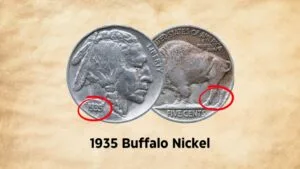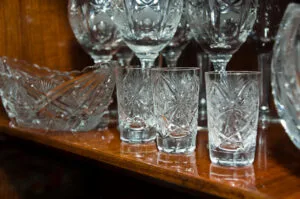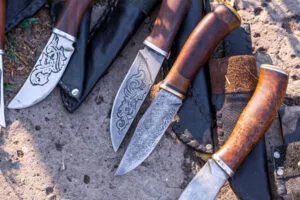If your father or grandpa loved fishing, you might have their tackle box in your shed. But you might not have opened that smelly box for almost all your life! But today, just put on a mask, open it and have a look. If you are lucky, you may get a valuable fishing lure inside!
Well, we are obviously not talking about the typical metal lures here. We mean artisanal wood lures that fetch more money than a lottery! So here, I have a list of all the features and costs to help you know how much your old lure’s worth! Are you ready to count your fortune?
Key Takeaways
- Vintage fishing lures used natural materials like wood, bone or shell walls, pearl eyes, feathers, and animal hair to catch more fish.
- If you want old, functional lures, get the ones that create vibrations or ripples in the water. Also, check other features like metal hooks, lips, and shafts.
- Old fishing lures have three stamps – patent numbers, brand, and size. And each of them will help you age and price your lure.
- Look for softwood, hardwood, brass, bronze, or copper baits for the best value.
What All Features Make a Fishing Lure Old & Antique?

It’s not that you don’t get painted or wooden fishing lures now. But those certainly won’t have custom fins, eyes, or hooks like the vintage models. Other than that, you’ll see those pigments, lacquers, and Shellac paints you don’t see today!
And it’s these handmade features, plus the rare traits below, that make a fishing lure vintage:
- Chiseled wood, bone, or shell bodies with a treble-like hook and shaft
- Composite structure with iron hooks, diving lips, and segments
- Simple glass eyes with pearl backing or wire thread
- Feathers or animal hair frills on each hook
- Aging signs – Chipped paint, Discoloration, or Brownish Metal Patina
When Did Vintage Fishing Lures Evolve & How?
Now, you might have seen commercial lures from the 1900s. But the vintage ones had much deeper roots. In fact, archaeologists say that the first fishing lures date back to the Chinese era, roughly around 2100 BC. So, these had prehistoric bone or shell bodies.
Things were a bit different in the 1800s. Man now had wood and metal working tools like pliers and saws. So, he could shape metal and design abstract fish or insect-shaped lures. Other than that, you’ll also see copper, brass, or bronze chains and hooks!
Fast-forward to the 1900s when it was all commercial and branded! You’ll see fancy lures with shiny glass eyes, hooks, and carved designs. And these undoubtedly fetch the highest value of all!
The 1940s were more vulnerable! Companies lost their money and materials due to the Economic Depression. So, makers focused on minimal plastic hooks and nylon wires to make cheap, low-quality baits.
But not for long! Enter Tom Mann in the 1960s! He was so inspired by the typical meat and food baits and created one! For this, he mixed fruit flavors in plastic and molded them into worms in a machine. And these are still very common, costing $8 – 10 for one!
7 Types of Antique Fishing Baits & Their Base Prices
It’s not that every fishing lure has a pointed hook and wires. Some also have rare, hand-molded shapes and designs, such as the seven types below:
1. Wood Minnows (1800s)
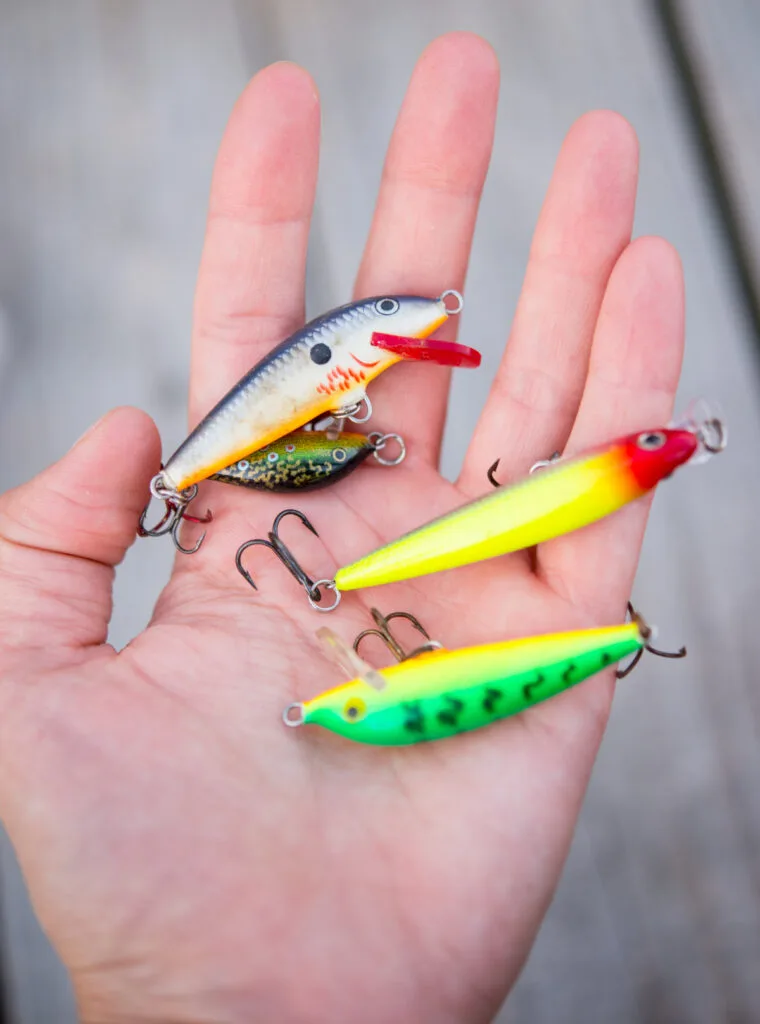
Ever looked at the small, fish-like baits in cartoons? Well, wood minnows are the same but have hooks and shiny glass or metal eyes. They are also tapered and have crude metal lips and rings that wobble in water. Overall, you can value one for $50 – 400, as per size.
2. Top Water Lures
We all know that any surface bubbles or noises attract fish. Well, topwater lures use the same principle and create surface vibrations or splashes. Most also have a cigar body and propellers for more noise. But since they are new and modern, they cost $20 – 200 for one.
3. Spoon Lures (1906)

Just as the name implies, these curved, vintage spoon baits have a convex surface and a flat top. These are bold and often have shiny copper, silver, or brass hooks to attract fish. So, these cost about $7 – 200, depending on the material.
4. Spinnerbaits (1930)

Now, imagine a solid, tear-shaped bait with 2-3 metal blades around the shaft. That’s exactly how a spinner bait looks! You can also find plastic or metal trailers, hooks, and beads for better grip. And depending on the material and working, you can price them for $10 – 80.
5. Crankbaits
Want something to catch the fancy, deep-water fish? Well, crankbaits, costing $1-140, might be the right option for you! To spot one, try looking for bass, muskie, and trout shapes with deep-diving lips. Other than that, look for square bills and sound holes at the top!
6. Vintage Jigs

If your fishing bait has a bulky metal head and twisted hair, rubber, or feather hooks, it might be an old jig, costing $4 – 140. Such thick lures have solid lead, tungsten, or tin walls and hooks. Plus, they have a slight bouncing or bumpy action. So, do check their shafts!
7. Old Swimbait Lures
Does your fishing bait look like feathered or hairy insects and worms? If yes, you might have a swim bait lure worth $9 – 45. Generally, these are more modern and have a thin wire frame, steel fly rod, and reel. But, they are a bit small, just ¼ to ½-inch in length.
6 Factors That Will Help You Identify & Value Your Antique Fishing Lures
Common vintage fishing lures are generally worth $5 – $20, with rare and old, branded lures fetching up to $100 – $200. These values highly depend on the fishing bait’s age, material, brand, and style, as explained below!
1. Vintage Fishing Lure’s Date & Age

As an antique expert, I always say, ‘the older, the better.’ But with fishing lures, it’s a different story! Here, it’s the shiny and carved 1900s models that fetch the highest price. In contrast, the simpler baits of the 1800s are relatively cheaper! The later 1950s lures are common!
But how do you know the manufacturing year of your old fishing lure? Well, the first, most obvious clue is to check the patent number on its box or lips. Below, we have compiled some for reference!
| Year | Age | Patent Number | Estimated Valuation |
| 1971 | 52 years | US3757455A (Patent for Artificial, Scent-emitting Baits) | $15 – 60 |
| 1980 | 43 years | 4794720 (Patent for Inflated Fishing Baits) | $12 – 50 |
| 1980 | 43 years | 4201008 (Patent for Fishing Lures with Spinners) | $9 – 50 |
But if you don’t find a patent number, here are some identification cues:
The 1800s Lures
One thing that separates the old 1800s lures from the rest is the use of natural wood, bone, and metal. Also, look for simpler fish or insect forms and wood-chiseled walls. Apart from that, you’ll also see feather or animal hair hooks in these, costing around $5 – 120 for one.
The 1900s Lures
This era was of branded and mass-produced products. So, you’ll see fancy, realistic lures with wood cores and metal carvings or casing. Most will also have 3-4 pointed hooks, rubber seals, and hand-painted finishes. As per the carvings, they are a bit costly, at $12 – 250.
The 1940s Lures
Just as we saw above, the 1940s lures were minimal because of the Economic Depression. You’ll see that most of them have solid walls, small iron hooks, and rubber or plastic chains. And such brittle materials lower the cost from $5 – 100.
The 1960s Lures
If your fishing lure looks like a worm or catfish with vibrating walls and propellers, it might be a 1960s lure. Such lures are very flexible and have shiny, fiber bodies that attract fish. But, these are relatively cheaper, from $2 – 50.
Check the weight of your lure. It must be 1 – 2 ounces for a solid, old make.
2. Vintage Fishing Lure Materials
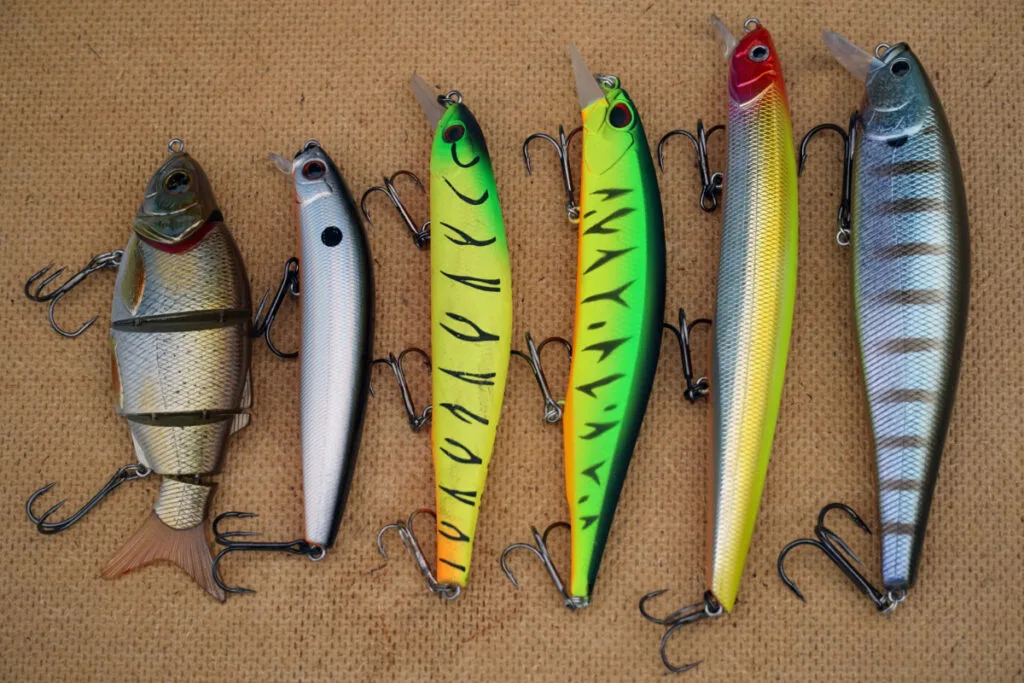
Well, it’s not just the age; even a lure’s material affects its cost greatly! That’s because each material has different features like buoyancy and vibrations that attract different fish! So, let’s see the unique traits and average prices of those!
| Old Fishing Lure Materials | Top Features | Average Cost |
| Softwoods – Pine, Cedar, Basswood | Curved and Tapering forms with metal hooks and fins, Surface Buoyancy | $14 – 250 |
| Hardwood – Maple, Oak, Ash & Walnut | Thick, linear shapes and slightly vibrating propellers | $10 – 120 |
| Cast & Alloyed Iron, Steel | Durable, Brushed, and Thick, Gray walls with rotating spinners | $13 – 90 |
| Brass, Copper, Bronze | Bulging lures with shiny, chrome-plated surfaces | $9 – 100 |
| Aluminum, Vinyl & Rubber | Soft-body lures with abstract, flexible shapes and brushed finishes | $1 – 50 |
| Plastic | Lightweight lures with bold colors, metal hooks, and molded shapes | $9 – 70 |
Try to get the limited-edition Balsa wood or metal-lipped lures for more returns.
3. Old Fishing Lure Use
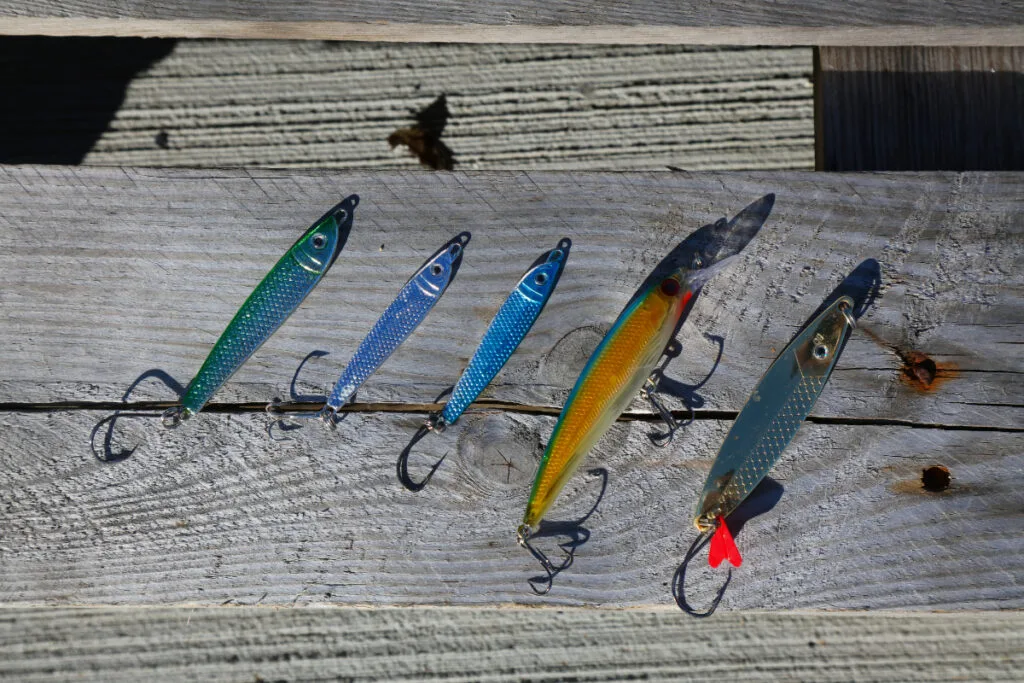
We all know that people use lures and bait for fishing. So, what is this use exactly?
Well here, we mean the depths and designs for each fishing lure. You see, people didn’t use the same lures for fresh water, deep sea, and ice fishing. So, each obviously has different hooks and water pressure resistance. And here, let’s know the costs for each!
| Old Fishing Lure Use | How to Identify? | Rough Value |
| Freshwater Lures | Bold colors, Bulging or Curved bodies, End hooks, and black or red eyes | $3 – 900 |
| Deepwater, Sea, or Ocean Lures | Pointed, linear forms with 2 – 3 hooks and flexible tails | $5 – 270 |
| Ice Fishing Baits | Thick, double-walled wood baits with bulging centers, sort tails, and gills | $30 – 450 |
Get fishing lures with bold colors like natural green, silver flash, or red for the best value.
4. Antique Fishing Bait Brands

If you want sturdy, durable, and precious lures, get branded ones. To check if your lure is branded, check the logo on its packing box. But, if you don’t have the box, look for the brand’s initial letter on the lure. For example, a Heddon bait will have an ‘H’ and so on.
Below are some fishing lure brands and values for you:
| Old Fishing Lure Brands | Average Size | Average Value |
| Heddon | 3 – 20” | $15 – 1000, as per size |
| Creek Chub | 4 – 11” | $6 – 580 |
| Rapala | 2 – 25” | $10 – 300 |
| Arbogast | 2 – 10” | $5 – 450 |
Avoid getting chipped, faded, or crystallized fishing lures as those might lose their value by 4 – 5%.
5. Rare Fishing Lures
Did you know that one of Ricky Haskell’s lures fetched $100,000 at a bid? Crazy, isn’t it? Well, it’s so that large, solid wood or gold-painted lures are not that easy to get. The same holds true for world-war era lures too! So, do check the lure’s origins before valuation.
And here are some examples of rare fishing lures that sell big!
| Rare Fishing Lures | Auction Cost |
| Haskell Musky Minnow (1859) – 7” | $32,000 |
| Musky Charmer Minnow – 5” | $25,000 |
| Heddon Black Sucker – 6” | $19,000 |
| Shakespeare Wooden Minnow (1907) | $18,700 |
| Wiggletail Smith Minnow (1905) | $17,000 |
6. Vintage Fishing Lure Eyes
Antique fishing lures with hand-painted or black bead eyes are more valuable than those with glass eyes. That’s because the painted ones are old, customized, and have rare, natural pigment paints.
How Do You Date Old Fishing Lures?
You can date old fishing lures by the stamped dates, patent numbers, or logos on their box. Other than that, check its materials and eyes to track the era. Usually, lures with wood walls and painted eyes are old.
How Do You Remove Rust From Vintage Fishing Lures?
Make a 1:2 solution of vinegar and water, and soak your lures overnight. Now, rinse it with soapy water and scrub it with a soft-bristled brush to remove the rust.
Which is the Best Color for a Vintage Lure?
Usually, natural colors like white, watermelon, green, brown, or red lures are the best, as they attract more fish and have natural pigments.
I know people are always in a rush for fishing! Like, they just want to attach the lure and flaunt their catch!
But trust me! Our guide and its easy-to-follow steps won’t take much time! You just need to get a magnifying glass, check the stamps, and match them with our table. That’s all! But if you are looking for a similar, step-wise identification and value guide for ‘old fishing rods,’ join me now!
Note: This article is intended for informational, educational, and entertainment purposes only. Some images are illustrative and may not represent actual brands, products, or related entities. All trademarks, product names, brand logos, packaging, and other intellectual property referenced remain the exclusive property of their respective owners. Any brand mentions or references are provided solely for descriptive and educational context and do not imply any formal or commercial association.





